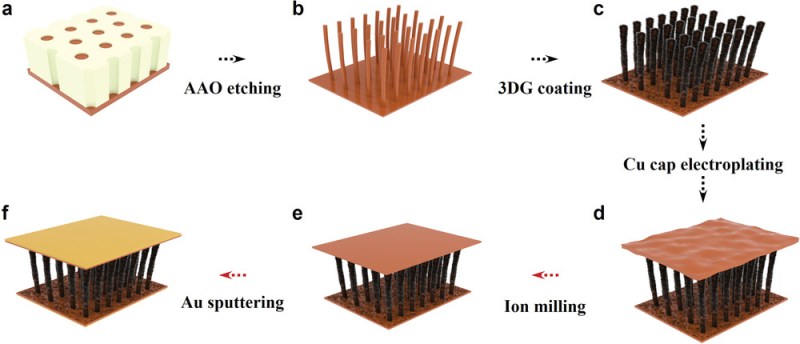With the increasing waste heat production by today’s electronics in ever smaller spaces, drawing this heat away quickly enough to prevent thermal throttling or damage is a major concern. This is where research by Lin Jing and colleagues from Carnegie Mellon University’s Department of Mechanical Engineering demonstrates a thermal interface material (TIM) that should provide a significant boost here. In the article, published in ACS Nano (paywalled; open access preprint alternative) the construction of this copper and graphene ‘sandwich’ TIM is described, along with tests.
The general idea is to use pillars between the two surfaces that can quickly carry the heat from the hot surface to the cool one. Although pure copper versions exist and do work, they suffer from the complications of having to build up these copper pillars in place, and subsequent oxidation reducing the effectiveness. While graphene and similar materials have shown superior heat-transfer capabilities, interfacing these materials with copper and other metals has proven problematic.
What Lin Jing et al. demonstrate in this study is to use essentially the pure copper approach, but to combine it with earlier research by Raghav Garg et al. (2017), who demonstrated how to grow 3-dimensional graphene structures. By cladding the copper pillars with graphene, this material improves heat transfer by 60%, while preventing oxidation of the metal. While the challenge is obviously to transfer these findings to something that can be mass-produced for consumer devices, it demonstrates how much potential there is in the use of graphene, which is a relatively new material for such applications due to how hard it was to produce until recently.
















I’m missing the why to using a whole copper block instead of a pillar structure. What is the benefit ?
That was my thought also. Normally you only use this sort of pillar structure if you are pushing some kind of fluid through the spaces between the pillars to cool or heat one or both skins of the assembly.
If the design was to allow air or liquid flowing through, pillar structure means more surface area for heat transfer off pillars into air or liquid. Otherwise, a solid copper block would be better.
RTFM guys. The pillar structure allows flexibility to fill gaps that a solid material won’t.
They also claim a thermal conductivity 10-20x better than solder (so, twice as good as solid copper). One will presume it’s because of stuff like “graphene” and “nanowires” and maybe “magic”.
It will be interesting to see if anything comes from this.
I am impressed by the “graphene” (graphite) TIM I’ve been testing lately, but it’s no match for solder.
More “magic” to be released.
Flexing the pillars just bends them and pushes them together, so you may as well use a layered graphene-copper sandwitch in an application that requires bending / forming to a particular surface.
It’s TIM, used to replace whatever solder/thermal paste… not plain block of material…
Next, make the pillars hollow and combine a coolant with capillary action.
The graphene can become gore tex, to let the pillars “breathe”.